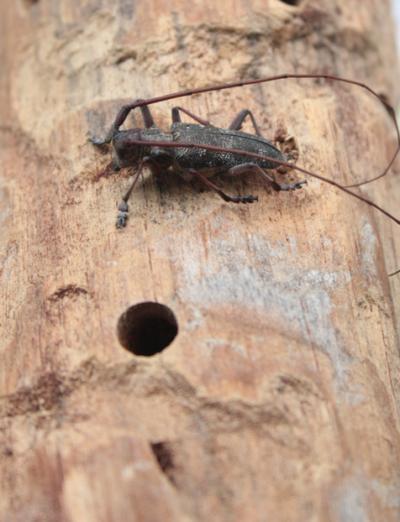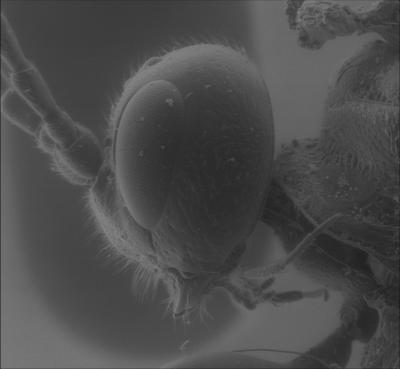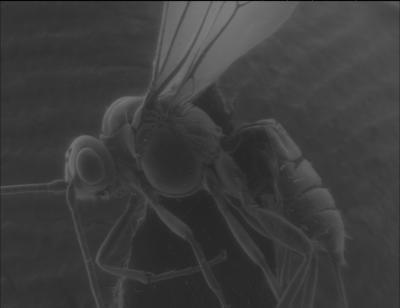With the purpose of developing new biological methods to control one of the major pests affecting the southwest Europe pine stands, a joint collaboration leaded by the Instituto Nacional de Investigação Agrária e Veterinária, Portugal (R. Petersen-Silva, P. Naves, E. Sousa), together with the Universidad de Barcelona, Spain (J. Pujade-Villar) and a member of the Museum and Institute of Zoology from the Polish Academy of Sciences, Poland, (S. Belokobylskij) initiated a research to detect the parasitoid guild of the Pine Wood Nematode (PWN) vector, Monochamus galloprovincialis (Olivier).

Monochamus galloprovincialis; the beetle responsible for the spreading of PWD in Portugal and his hole of emergence in a pine branch.
(Photo Credit: Ricardo Petersen-Silva)
As the disease slowly spreads across the far west corner of Europe, numerous studies and research lines are being developed. In the last two years, an extensive field work across the entire Portuguese territory, found the presence of 5 small wasps species that directly attack the younger life stages of this pest carrier. The study was published in the open access journal ZooKeys.
"Also considering previous reliable records, showed that worldwide there is now a total of 14 species of potential candidates associated with the bio-control of the vector" said the leading author R. Petersen-Silva. Besides Portugal, some of these findings have been made in other countries such as Italy and Russia (Siberia).

This shows Odontocolon quercinum, and the face detail of one of the candidates for biological control of the vector.
(Photo Credit: Ricardo Petersen-Silva)
Two of the species now found in Portugal offer promising perspectives: "Despite their generalist habits, they are the most frequent and promising candidates for studies aiming the biological control of the pine sawyer", according to the leading author. All of these wasps are no bigger than a few millimeters, and are known to base their lifecycle on the parasitism of much larger insect hosts. The biology and behavior of these small wasps is not well known yet, and should be studied in the future to help define the best candidate for the control of this pine sawyer.
The obtained results showed that well managed pine stand allow the maintenance of more stable insect communities that more easily control de proliferation of invasive forest pests.
As a result, future trials on the ecology and suitability of these small wasps are being planned by the various researchers working on this project. This approach to the PWN problem could be an additional and deeply-needed step on the fight against the spreading of the disease. This study was co-funded by an European project (REPRHAME) intended to the Development of improved methods for detection, control and eradication of pine wood nematode in support of EU Plant Health Policy.

This shows Cyanopterus tricolor, electronic microscopy photo of one of the small wasps with interest for bio-control.
(Photo Credit: Ricardo Petersen-Silva)
Source: Pensoft Publishers